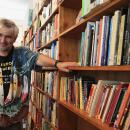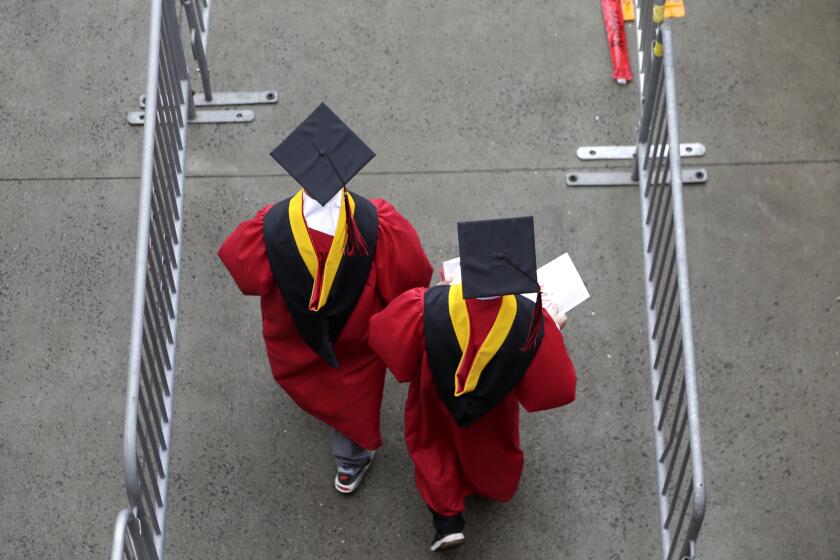Op-Ed: The Expo Line reconnects the pueblo and the Pacific
Starting Friday, you can board an Expo Line train in downtown Los Angeles and disembark in Santa Monica less than an hour later. If you live or work between Santa Monica and downtown, this new extension is obviously big news.
But what if you donât? Did Santa Monicans get all excited two months ago, when Metro extended the Gold Line from Pasadena to Azusa? Of course not. âPasadena? You canât even get a decent bowl of acai there.â
A train to the beach is different. You can tell by the way people refer to it. Nobodyâs talking about a train from the beach, though most assuredly the Expo Line is that too. The grand opening hoopla on Friday and Saturday (free rides, food trucks, Uber discounts from the Metroâs âOffice of Extraordinary Innovationâ) befits the rail re-connection, after 63 years and more than $1 billion, of the pueblo and the Pacific.
Despite all the bunting and ribbon-cutting, train lovers are nervous. Metro ridership has mysteriously dipped lately. Will the fares grow enough to justify the Expo Lineâs cost? Will the trains move enough people to lighten the road load? Will folks in Huntington Park or Pacific Palisades, still remote from the Expo Line (and most of the rest of Metroâs projects) care enough to help pass the next transit sales tax hike, Measure R2?
It might help if the doubters just took the ride, picking up the train at the elevated Culver City platform, where the line used to end. The extension swoops over a graceful bridge athwart Venice Boulevard and makes seven new stops en route to the horizon.
Palms Station comes first. The late patron saint of Los Angeles mass transit, author Ray Bradbury, would have been very happy if heâd lived to see this weekend. An indefatigable monorail champion who never learned to drive, he could have coasted his trusty ten-speed to this stop from his (since-demolished) home on Cheviot Drive. Tellingly, the last paragraph of âFahrenheit 451â (L.A.âs current citywide Big Read) isnât the indictment of censorship or conformity you might expect, but a hushed prayer for the rebirth of the novelâs shattered metropolis, a fragment that wouldnât be out of place engraved over a Metro platform: âWhen we reach the city.â
From Palms, Expo burrows west under the 10 to the Rancho/Westwood Station. Almost a mile from Rancho Park and two miles from Westwood, this one would surely be named after the surrounding Cheviot Hills neighborhood if the residents hadnât fought so hard to keep the train out. After local bipeds and quadrupeds start to use the long, lovely new Westwood Greenway abreast of the tracks, they may feel differently
Tacking parallel to Pico, the train levitates to Sepulveda Station, where drivers on the 405 can jettison their cars in Expoâs largest parking structure. Then the line rollercoasters under the San Diego Freeway, gathering speed through the brief, shady crossing of rail and road.
Ultimately, riding the light rail line itself isn’t the point. The point is how trains and bikes and cars and even feet all fit together.
Next comes Bundy Station, just up the street from the old Douglas Aircraft factory that became Santa Monica Airport. The plant ran 24 hours a day during World War II, and workers not only toiled in shifts but lived that way, three for every bed in a dorm at the plant, coming and going every eight hours. And you think housing on the Westside is hard to come by now?
Then Santa Monicaâs Bergamot Station heaves into view, a former Pacific Electric rail yard turned art hot spot, named for the aromatic plant that used to bloom around here. Just nine blocks later the train pulls into quiet 17th Street/Santa Monica College Station. Half residential, half light-industrial, the neighborhood sits a home-run away from a Little League field and half a mile north of the campus â and unlike Cheviot Hills, it fought for a station of its own.
The train accelerates down the homestretch of Colorado Boulevard, past the refurbishing Tulip Cafe, surely a mecca-to-be for ferroequinologists â literally, students of the iron horse â before slowing, finally, to dogleg and foghorn across Fourth Street and into the bay at the Downtown Santa Monica Station. (The bay between platforms, that is.)
And there, after I impiously drove the length of the line last weekend, I beheld a transit system secret weapon: racks of smooth-riding, 8-speed, $6-an-hour, Key-lime-green rental bicycles.
I hopped on one, and instantly I got it. This is what all those messianic L.A. urbanistsâ current Metro mania is about. Itâs great that you can now get to the beach without worrying about the flash of old traffic warrants in your rear view mirror. And you donât need to grow old circling the block looking for parking in Santa Monica. But ultimately, the opening of the Expo Line itself isnât the point. The point is how trains and bikes and cars and even feet all fit together.
If L.A. can get its connections right, even the most transit-skeptical Angelenos â whether a Lyft-hailing, resolutely independent millennial or his single-family-home-dwelling centenarian grandpa â may yet rethink where public transportation can take them.
I finished my ride at Santa Monicaâs Camera Obscura in Palisades Park. Itâs a kind of walk-in pinhole camera, reflecting the image of everything around it through an aperture on the roof and down onto a tilted disk about six feet across.
Swiveling its mirror toward downtown, I tried to convince myself I could see the L.A. skyline. I couldnât even make out the Expo Line terminus four blocks away. Somewhere back down the tracks lay the lineâs namesake, Exposition Park, once home to the Museum of Science and Industry and the most amazing model train set in the whole wide world.
The whirring electric miniature cars were cool and all, but it was the sweet, bustling, twinkling little lakeside town that really made it go.
David Kipen will cohost a Big Read public discussion, âWhen We Reach the City: Ray Bradbury and the Future of Los Angeles,â Sunday at Cliftonâs Cafeteria.
Follow the Opinion section on Twitter @latimesopinion and Facebook
More to Read
A cure for the common opinion
Get thought-provoking perspectives with our weekly newsletter.
You may occasionally receive promotional content from the Los Angeles Times.











